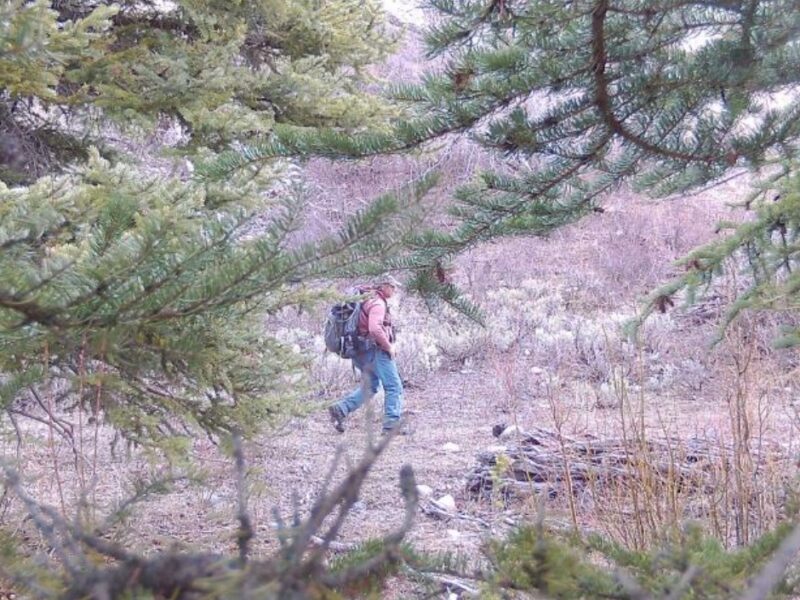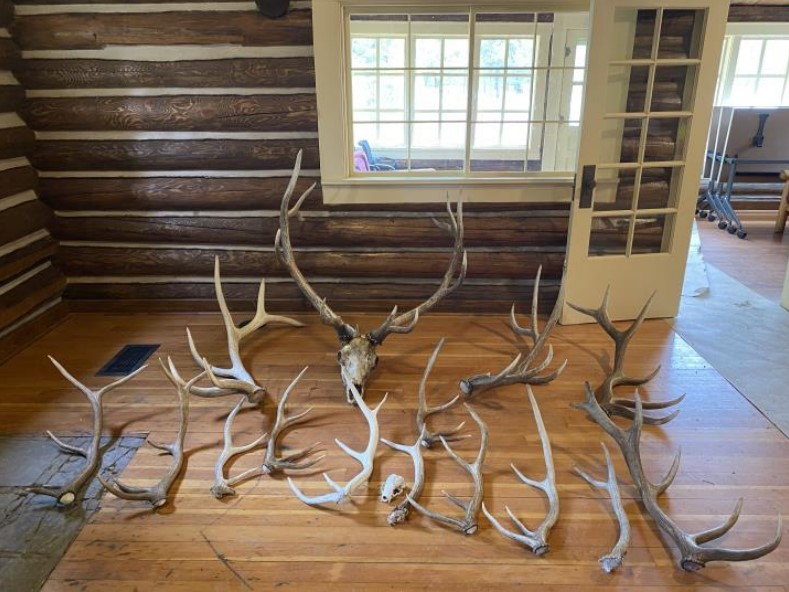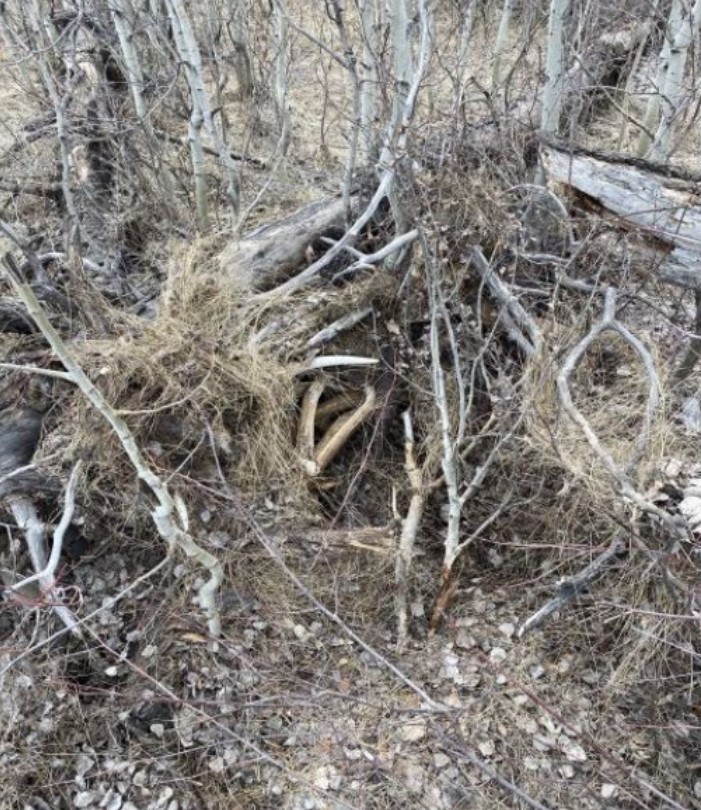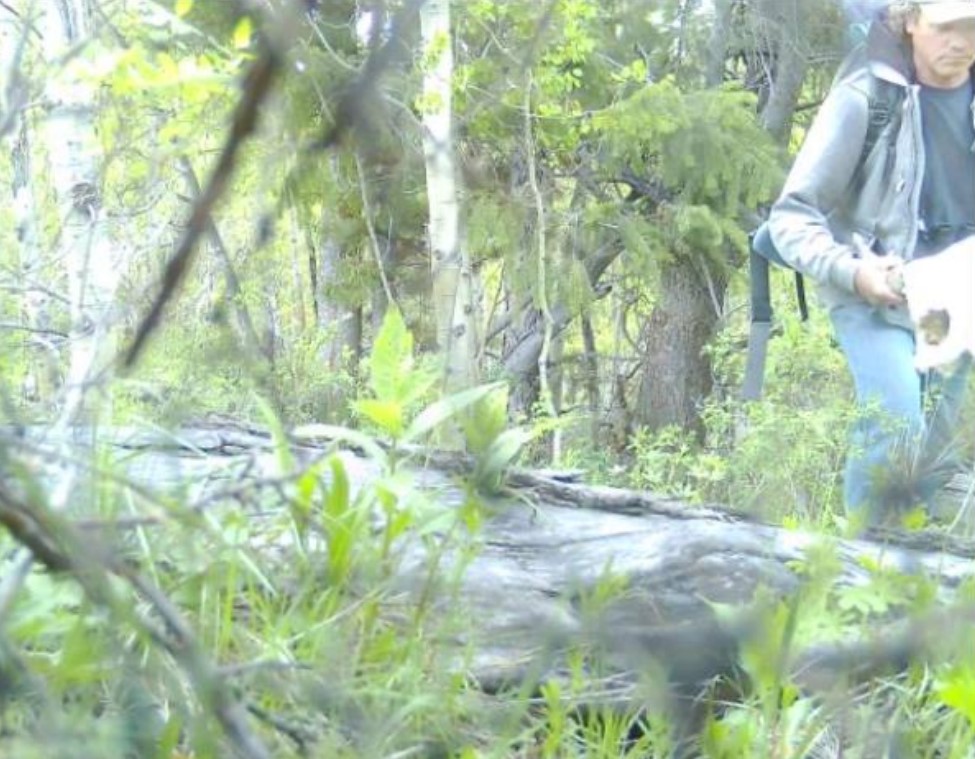Idaho Man Ordered to Pay $5K For Taking Antlers From Grand Teton
Defendant twice collected government-tracked decoys
- Published In: Criminal Justice
- Last Updated: Aug 26, 2023

A government-placed camera captured this image of Jeremy Ward hiking near Wolf Ridge in Grand Teton National Park on April 28, 2022. Prosecutors say he illegally hunted for antler sheds in the park before the season opened on May 1. (Courtesy photo from the National Park Service via U.S. District Court records)
By CJ Baker
Special to the Wyoming Truth
It seemed like a banner day of shed hunting for Jeremy Ward. In early May 2022, the Idaho resident boasted to a friend that he’d collected 43 antlers in just a day of searching the Jackson Hole area.
“Slaying the antlers. Did really good yesterday,” he texted another friend on May 3, 2022, according to court documents. “Hope today is good too.”
But things were not going as well as Ward thought: He’d illegally ventured into Grand Teton National Park and unwittingly grabbed a pair of GPS-tracked decoys — putting rangers hot on his trail — while his brag about dozens of antlers would eventually lead to a $5,400 bill from the federal government.

Ward pleaded guilty to a misdemeanor count of illegally transporting wildlife in March and received a year of supervised probation, including four months of house arrest. Last week, U.S. District Court Judge Scott Skavdahl also ordered the 49-year-old to pay for the antlers he’d taken from Grand Teton — despite objections from Ward’s attorney that the National Park Service wasn’t entitled to restitution.
Illegal shed hunting is a perennial problem in the Jackson Hole area. Last year, the owner of a Montana-based company that sells elk antler dog chews pleaded guilty to a felony for collecting sheds out-of-season in 2021; federal prosecutors said Joshua Anders Rae had done the same thing two years earlier and reoffended while still serving probation and paying off $15,000 in restitution.
In an effort to protect wintering wildlife, Wyoming prohibits shed hunting from Jan. 1 through April 30 west of the Continental Divide. Lawmakers added new limits on out-of-state shed hunters last winter, requiring them to buy a $21.50 conservation stamp and giving Wyoming residents a one-week head start to the season.
Catching violators can be a challenge, not only because of the vast amount of public lands, but also because of the sheer volume of shed hunters; the Jackson region is inundated each spring with people hoping to profit from the antlers dropped by elk, moose and deer. Ward’s case illustrates how far authorities will go to enforce the law.
Planting and tracking decoys

Court documents indicate Ward’s shed hunt was illegal from the start. He began gathering and stashing antlers around April 20, 2022 — roughly a week-and-a-half too early — and wound up crossing from the Bridger-Teton National Forest into Grand Teton., where the practice is prohibited all year long.
In the wilds of the park, such an infraction could go undetected, but the boundary area around Spread Creek is a hot spot for illegal shed hunting. As part of their continuing efforts to catch scofflaws, rangers had constructed decoys with GPS tracking technology and placed them in Grand Teton along Wolf Ridge.
“Unbeknownst to Mr. Ward, U.S. Park Rangers had planted a GPS device in the elk skull and one of the elk antlers he found around this time [in April],” his court-appointed attorney, Jordan Deckenbach, wrote in a filing.
On May 2, after the season had opened, Ward returned to the area, searched for more sheds and retrieved some he’d already stashed inside the park, according to court records. In a later text, Ward said he’d collected 43 antlers that day, including a “couple of giants.” Prosecutors said he then sold them.
Ward returned to Spread Creek on May 4 to shuttle more antlers from his cache to a road, where his partner could pick him up. Prosecutors said the pair had been trying to avoid law enforcement, but the GPS trackers inside the decoy antlers led rangers right to Ward, who was found “hiding in the willows.” They seized Ward’s cellphone and 76 pounds of antlers.
Ward received a citation for removing animal parts from the park, but the U.S. Attorney’s Office soon dismissed it. Law enforcement officers were continuing to investigate the case — getting a warrant to comb through Ward’s cell phone data — but the suspect apparently thought he was in the clear.
Ward returned to the Spread Creek area and his cache in mid-June 2022, court records show. Once again, however, he collected a decoy on Wolf Ridge — a bison skull that rangers had planted just days after their first encounter with Ward. He was intercepted again on June 14, where rangers seized the skull and three more antlers in his possession.
A grand jury indicted Ward and partner Robin Lehat the following month. Prosecutors struck a pretrial diversion agreement with Lehat last year and agreed to drop a felony theft charge against Ward, resulting in the year of probation. However, the parties remained at odds over restitution.
Paying by the pound
Deckenbach argued the government hadn’t suffered actual losses.
“Though these antlers have a value when sold by a private individual, they do not represent a corresponding value or loss to the National Park,” Deckenbach wrote in a filing, asserting the government didn’t have “the right or opportunity to profit” from the parts.
Further, the attorney argued that Ward’s boast of a 43-antler day was an exaggeration. The defendant contended he’d actually brought some of the antlers from Idaho and had been apprehended before he could grab a larger stash in June. In the end, Ward contended that he’d only made it out of Grand Teton with eight antlers. At seven pounds per antler and $18 per pound, Ward shouldn’t owe more than $1,008, Deckenbach contended.

Prosecutors, however, argued Ward should have to pay $5,418 for the 43 antlers he’d bragged about, plus $2,520 for another 140 pounds they suspect he took in June. Although Ward said he never retrieved those additional antlers, authorities said the stash disappeared around the time he was spotted in the area.
Assistant U.S. Attorney Michael Elmore also contended the government should receive restitution, saying Ward’s actions “directly violated the spirit of the National Park System’s purpose.”
“The Defendant unlawfully removed wildlife parts from an area of common public enjoyment, which … constitutes a clear value deprivation for other park visitors and for the National Park System itself,” Elmore wrote.
Following an Aug. 17 hearing, Skavdahl ordered Ward to pay $5,418. The judge gave Ward until the end of his probation to pay the government, but left the door open to an extension.
The restitution added to an already expensive trip for Ward and Lehat: They previously told rangers they’d sold $2,000 worth of antlers, but spent $4,000 traveling to Jackson.













